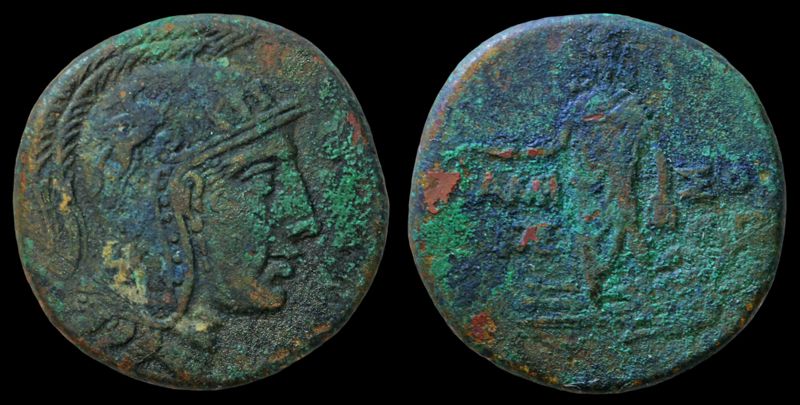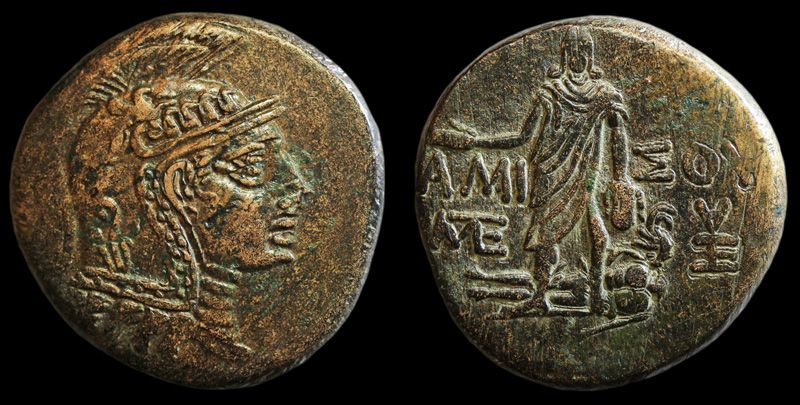Pontos, Amisos: Perseus and the slain Medusa
This is a feel-good story with a happy ending.
No, not for poor headless Medusa... for me. I'm referring to the the acquisition of and subsequent adventures with this coin.
I'm referring to the the acquisition of and subsequent adventures with this coin.
I had just purchased a very nice example of the type in February and didn't really need another but I couldn't resist. There are no coin stores where I live.
Last month while working in a nearby town, I stopped by a jewelry store which has a large selection of tragically high-end ancient coins set in jewelry. They usually have a small number of unset coins although every time I looked, those were just poor condition late Roman bronzes and a few near-basal-state Syracuse obols.
From across the room I saw a big but heavily corroded bronze. Although covered in rough green and blue, its identity was apparent from several feet away. I bought it immediately-- for sixty bucks, why not?

The overall look was very nice as-is, despite the lack of good detail on the reverse. It resembled a nice piece of chrysacolla. I debated leaving it alone but since I already had a good example, why not try to improve this one? I was hoping there would be some details on the reverse. The reverse of this type is the money side, in my opinion.
I grabbed a scalpel and gently pried at a flake of green. It didn't come off easily and I exposed a teensy speck of bright bronze. Method aborted.
Realizing the green and blue copper oxides could be dissolved in acid, I tossed it into a cup of vinegar. The vinegar began to turn light blue after an hour. I soaked it for half a day, changing the vinegar a few times and occasionally wiping it with a cotton-tipped swab and a few swipes with an old toothbrush. After rinsing in distilled water I soaked it in a hot solution of sodium sesquicarbonate (home version: an approximately equimolar mixture of sodium carbonate and sodium bicarbonate), rinsed again, dried, and applied Verdicare. Corrosion and bronze disease are accelerated in my environment so I treat all of my bronze coins, with Verdicare at minimum.
I couldn't believe it! Underneath the oxides the details were fantastic! All of the major features are there and they are crisp: the full body of Medusa, the gushing blood, Medusa's head in Perseus's hand, the harpa... On the obverse, Athena and her helmet fared equally well.

PONTOS, Amisos
85-65 BC, time of Mithradates VI Eupator
AE29, 19.5 gm
Obv: helmeted head of Athena right; gryphon on helmet
Rev: AMI-ΣOY; Perseus standing facing, holding harpa & Medusa's head; Medusa's body at his feet, monograms flanking him
Ref: SNG BM Black Sea 1166; Stancomb 684; SNG Copenhagen 137 (best guess)
Overall, I like it even better than the coin below which was purchased at auction in February, although the auction coin does have a spectacular reverse-- the best gushing blood of any ancient coin, don't you think?

PONTOS, Amisos
85-65 BC, time of Mithradates VI Eupator
AE28, 18.5 gm
Obv: helmeted head of Athena right
Rev: AMIΣOY; Perseus standing facing, holding harpa and head of Medusa, Medusa's body at his feet
Ref: SNG Stancomb 683 var. (no monogram to right). [I cannot verify this reference and suspect it may not be correct because there are monograms both left and right. Looks like Sear 3637 fits though]
A brief summary of the story of Perseus and Medusa:
<< <i>This coin depicts two figures from the legend of Medusa, who was once a beautiful young maiden who dared to challenge Athena's beauty. As punishment for her impiety, Medusa’s hair was turned into hissing serpents and condemned to turn every living thing which gazed upon her to turn to stone. Perseus, son of Zeus and the mortal Danae, was given the task of slaying this monster. He was aided, in part, by Athena who gave her shield to him for the task. In the context of the period which this coin is from, Perseus and Medusa would be representations of Mithradates VI and Rome, respectively.
<< <i>
- from CNG's archives
No, not for poor headless Medusa... for me.
I had just purchased a very nice example of the type in February and didn't really need another but I couldn't resist. There are no coin stores where I live.
Last month while working in a nearby town, I stopped by a jewelry store which has a large selection of tragically high-end ancient coins set in jewelry. They usually have a small number of unset coins although every time I looked, those were just poor condition late Roman bronzes and a few near-basal-state Syracuse obols.
From across the room I saw a big but heavily corroded bronze. Although covered in rough green and blue, its identity was apparent from several feet away. I bought it immediately-- for sixty bucks, why not?

The overall look was very nice as-is, despite the lack of good detail on the reverse. It resembled a nice piece of chrysacolla. I debated leaving it alone but since I already had a good example, why not try to improve this one? I was hoping there would be some details on the reverse. The reverse of this type is the money side, in my opinion.
I grabbed a scalpel and gently pried at a flake of green. It didn't come off easily and I exposed a teensy speck of bright bronze. Method aborted.
Realizing the green and blue copper oxides could be dissolved in acid, I tossed it into a cup of vinegar. The vinegar began to turn light blue after an hour. I soaked it for half a day, changing the vinegar a few times and occasionally wiping it with a cotton-tipped swab and a few swipes with an old toothbrush. After rinsing in distilled water I soaked it in a hot solution of sodium sesquicarbonate (home version: an approximately equimolar mixture of sodium carbonate and sodium bicarbonate), rinsed again, dried, and applied Verdicare. Corrosion and bronze disease are accelerated in my environment so I treat all of my bronze coins, with Verdicare at minimum.
I couldn't believe it! Underneath the oxides the details were fantastic! All of the major features are there and they are crisp: the full body of Medusa, the gushing blood, Medusa's head in Perseus's hand, the harpa... On the obverse, Athena and her helmet fared equally well.

PONTOS, Amisos
85-65 BC, time of Mithradates VI Eupator
AE29, 19.5 gm
Obv: helmeted head of Athena right; gryphon on helmet
Rev: AMI-ΣOY; Perseus standing facing, holding harpa & Medusa's head; Medusa's body at his feet, monograms flanking him
Ref: SNG BM Black Sea 1166; Stancomb 684; SNG Copenhagen 137 (best guess)
Overall, I like it even better than the coin below which was purchased at auction in February, although the auction coin does have a spectacular reverse-- the best gushing blood of any ancient coin, don't you think?

PONTOS, Amisos
85-65 BC, time of Mithradates VI Eupator
AE28, 18.5 gm
Obv: helmeted head of Athena right
Rev: AMIΣOY; Perseus standing facing, holding harpa and head of Medusa, Medusa's body at his feet
Ref: SNG Stancomb 683 var. (no monogram to right). [I cannot verify this reference and suspect it may not be correct because there are monograms both left and right. Looks like Sear 3637 fits though]
A brief summary of the story of Perseus and Medusa:
<< <i>This coin depicts two figures from the legend of Medusa, who was once a beautiful young maiden who dared to challenge Athena's beauty. As punishment for her impiety, Medusa’s hair was turned into hissing serpents and condemned to turn every living thing which gazed upon her to turn to stone. Perseus, son of Zeus and the mortal Danae, was given the task of slaying this monster. He was aided, in part, by Athena who gave her shield to him for the task. In the context of the period which this coin is from, Perseus and Medusa would be representations of Mithradates VI and Rome, respectively.
<< <i>
- from CNG's archives
0
Comments
The issue with maintaining the coins, is one of the reasons why I opt for slabbing.
Thanks for sharing.
World Collection
British Collection
German States Collection
this line really sells it for me:
" In the context of the period which this coin is from, Perseus and Medusa would be representations of Mithradates VI and Rome, respectively."
Heres a nice greek banknote with Pallas Athena on the obverse and Medusa on the reverse.
end of the story , Perseus gave the chopped off head of Medusa as a gift to Pallas Athena , and she put the head on her shield,
the head was still working, now turning Athena's enemies into stone.
A question about the hi-end coins in jewelry--is it something they can recover from or are the coins ruined (which I suppose depends on the settings, but in general).
Andres-- that's a very interesting bill. Perhaps I should get one.
Stork--
the same note was also issued in green (1947) if that is your favorite colour